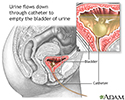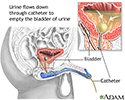Traumatic injury of the bladder and urethra
Injury - bladder and urethra; Bruised bladder; Urethral injury; Bladder injury; Pelvic fracture; Urethral disruption; Bladder perforationTraumatic injury of the bladder and urethra involves damage caused by an outside force.
Causes
Types of bladder injuries include:
- Blunt trauma (such as a blow to the body)
- Penetrating wounds (such as bullet or stab wounds)
The amount of injury to the bladder depends on:
- How full the bladder was at the time of injury
- What caused the injury
Injury to the bladder due to trauma is not very common. The bladder is located within the bones of the pelvis. This protects it from most outside forces. Injury may occur if there is a blow to the pelvis severe enough to break the bones. In this case, bone fragments may pierce the bladder wall. Less than 1 in 10 pelvic fractures lead to bladder injury.
Other causes of bladder or urethra injury include:
- Surgeries of the pelvis or groin (such as hernia repair and removal of the uterus).
Removal of the uterus
Hysterectomy is surgery to remove a woman's womb (uterus). The uterus is a hollow muscular organ that nourishes the developing baby during pregnancy...
 ImageRead Article Now Book Mark Article
ImageRead Article Now Book Mark Article - Tears, cuts, bruises, and other injuries to the urethra. The urethra is the tube that carries urine out of the body. This is more common in men than women.
- Straddle injuries. This injury may occur if there is direct force that injures the area behind the scrotum.
- Deceleration injury. This injury may occur during a motor vehicle accident. Your bladder can get injured if it is full and you are wearing a seatbelt.
Injury to the bladder or urethra may cause urine to leak into the abdomen. This may lead to infection.
Lead to infection
Peritonitis is an inflammation (irritation) of the peritoneum. This is the thin tissue that lines the inner wall of the abdomen and covers most of t...

Symptoms
Some common symptoms are:
- Lower abdominal pain
Abdominal pain
Abdominal pain is pain that you feel anywhere between your chest and groin. This is often referred to as the stomach region or belly.
 ImageRead Article Now Book Mark Article
ImageRead Article Now Book Mark Article - Abdominal tenderness
- Bruising at the site of injury
-
Blood in the urine
Blood in the urine
Blood in your urine is called hematuria. The amount may be very small and only detected with urine tests or under a microscope. In other cases, the...
 ImageRead Article Now Book Mark Article
ImageRead Article Now Book Mark Article - Bloody urethral discharge
-
Difficulty beginning to urinate or inability to empty the bladder
Difficulty beginning to urinate
Difficulty starting or maintaining a urine stream is called urinary hesitancy.
 ImageRead Article Now Book Mark Article
ImageRead Article Now Book Mark Article - Leakage of urine
-
Painful urination
Painful urination
Painful urination is any pain, discomfort, or burning sensation when passing urine.
 ImageRead Article Now Book Mark Article
ImageRead Article Now Book Mark Article - Pelvic pain
- Small, weak urine stream
- Abdominal distention or bloating
Shock or internal bleeding may occur after a bladder injury. This is a medical emergency. Symptoms include:
Shock
Shock is a life-threatening condition that occurs when the body is not getting enough blood flow. Lack of blood flow means the cells and organs do n...

-
Decreased alertness, drowsiness, coma
Decreased alertness
Decreased alertness is a state of reduced awareness and is often a serious condition. A coma is the most severe state of decreased alertness from whi...
Read Article Now Book Mark ArticleDrowsiness
Drowsiness refers to feeling more sleepy than normal during the day. People who are drowsy may fall asleep when they do not want to or at times whic...
 ImageRead Article Now Book Mark Article
ImageRead Article Now Book Mark Article - Increased heart rate
- Decrease in blood pressure
- Pale skin
- Sweating
- Skin that is cool to the touch
If there is no or little urine released, there may be an increased risk for urinary tract infections (UTI) or kidney damage.
Urinary tract infections
A urinary tract infection, or UTI, is an infection of the urinary tract. The infection can occur at different points in the urinary tract, including...

Exams and Tests
An exam of the genitals may show injury to the urethra. If the health care provider suspects an injury, you may have the following tests:
- Retrograde urethrogram (an x-ray of the urethra using dye) for injury of urethra
- Retrograde cystogram (imaging of bladder) for injury of the bladder
- CT scan
The exam may also show:
- Bladder injury or swollen (distended) bladder
- Other signs of pelvic injury, such as bruising over the penis, scrotum, and perineum
- Signs of hemorrhage or shock, including decreased blood pressure -- especially in cases of pelvic fracture
- Tenderness and bladder fullness when touched (caused by urine retention)
- Tender and unstable pelvic bones
- Urine in the abdominal cavity
A urinary catheter may be inserted once an injury of the urethra has been ruled out. This is a tube that drains urine from the bladder. An x-ray of the bladder using dye to highlight any damage can then be done.
Treatment
The goals of treatment are to:
- Control symptoms
- Drain the urine
- Repair the injury
- Prevent complications
Emergency treatment of bleeding or shock may include:
- Blood transfusions
- Intravenous (IV) fluids
- Monitoring in the hospital
Emergency surgery may be done to repair the injury and drain the urine from the abdominal cavity in case of extensive injury or peritonitis (inflammation of the abdominal cavity).
The injury can be repaired with surgery in most cases. The bladder may be drained by a catheter through the urethra or the abdominal wall (called a suprapubic tube) over a period of days to weeks. This will prevent urine from building up in the bladder. It will also allow the injured bladder or urethra to heal and prevent swelling in the urethra from blocking urine flow.
If the urethra has been cut, a urological specialist (urologist) can try to put a catheter in place. If this cannot be done, a tube will be inserted through the abdominal wall directly into the bladder. This is called a suprapubic tube. It will be left in place until the swelling goes away and the urethra can be repaired with surgery. This takes 3 to 6 months.
Outlook (Prognosis)
Injury of the bladder and urethra due to trauma can be minor or fatal. Short- or long-term serious complications can occur.
Possible Complications
Some of the possible complications of injury of the bladder and urethra are:
- Bleeding, shock.
-
Blockage to the flow of urine. This causes the urine to back up and injure one or both kidneys.
Blockage to the flow of urine
Obstructive uropathy is a condition in which the flow of urine is blocked. This causes the urine to back up and injure one or both kidneys.
 ImageRead Article Now Book Mark Article
ImageRead Article Now Book Mark Article - Scarring leading to blockage of the urethra.
- Problems completely emptying the bladder.
When to Contact a Medical Professional
Call the local emergency number (911) or go to the emergency room if you have an injury to the bladder or urethra.
Contact your provider if symptoms get worse or new symptoms develop, including:
- Decrease in urine production
- Fever
- Blood in urine
- Severe abdominal pain
- Severe flank or back pain
- Shock or hemorrhage
Prevention
Prevent outside injury to the bladder and urethra by following these safety tips:
- Do not insert objects into the urethra.
- If you need self-catheterization, follow the instructions of your provider.
- Use safety equipment during work and play.
References
Brandes SB, Eswara JR. Upper urinary tract trauma. Partin AW, Dmochowski RR, Kavoussi LR, Peters CA, eds. Campbell-Walsh-Wein Urology. 12th ed. Philadelphia, PA: Elsevier; 2021:chap 90.
Lang SC, Shewakramani SN. Genitourinary trauma. In: Walls RM, ed. Rosen's Emergency Medicine: Concepts and Clinical Practice. 10th ed. Philadelphia, PA: Elsevier; 2023:chap 39.
-
Female urinary tract - illustration
The female and male urinary tracts are relatively the same except for the length of the urethra.
Female urinary tract
illustration
-
Male urinary tract - illustration
The male and female urinary tracts are relatively the same except for the length of the urethra.
Male urinary tract
illustration
-
Bladder catheterization - female - illustration
A catheter (a hollow tube, often with an inflatable balloon tip) may be inserted into the urinary bladder when there is a urinary obstruction, following surgical procedures to the urethra, in unconscious patients (due to surgical anesthesia, coma, or other reasons), or for any other problem in which the bladder needs to be kept empty (decompressed) and urinary flow assured. The balloon holds the catheter in place for a duration of time.
Bladder catheterization - female
illustration
-
Bladder catheterization - male - illustration
Catheterization is accomplished by inserting a catheter (a hollow tube, often with and inflatable balloon tip) into the urinary bladder. This procedure is performed for urinary obstruction, following surgical procedures to the urethra, in unconscious patients (due to surgical anesthesia, coma, or other reasons), or for any other problem in which the bladder needs to be kept empty (decompressed) and urinary flow assured. The balloon holds the catheter in place for a duration of time. Catheterization in males is slightly more difficult and uncomfortable than in females because of the longer urethra.
Bladder catheterization - male
illustration
-
Female urinary tract - illustration
The female and male urinary tracts are relatively the same except for the length of the urethra.
Female urinary tract
illustration
-
Male urinary tract - illustration
The male and female urinary tracts are relatively the same except for the length of the urethra.
Male urinary tract
illustration
-
Bladder catheterization - female - illustration
A catheter (a hollow tube, often with an inflatable balloon tip) may be inserted into the urinary bladder when there is a urinary obstruction, following surgical procedures to the urethra, in unconscious patients (due to surgical anesthesia, coma, or other reasons), or for any other problem in which the bladder needs to be kept empty (decompressed) and urinary flow assured. The balloon holds the catheter in place for a duration of time.
Bladder catheterization - female
illustration
-
Bladder catheterization - male - illustration
Catheterization is accomplished by inserting a catheter (a hollow tube, often with and inflatable balloon tip) into the urinary bladder. This procedure is performed for urinary obstruction, following surgical procedures to the urethra, in unconscious patients (due to surgical anesthesia, coma, or other reasons), or for any other problem in which the bladder needs to be kept empty (decompressed) and urinary flow assured. The balloon holds the catheter in place for a duration of time. Catheterization in males is slightly more difficult and uncomfortable than in females because of the longer urethra.
Bladder catheterization - male
illustration
-
Back pain and sciatica - InDepth
(In-Depth)
Review Date: 5/17/2024
Reviewed By: Sovrin M. Shah, MD, Associate Professor, Department of Urology, The Icahn School of Medicine at Mount Sinai, New York, NY. Review provided by VeriMed Healthcare Network. Also reviewed by David C. Dugdale, MD, Medical Director, Brenda Conaway, Editorial Director, and the A.D.A.M. Editorial team.







